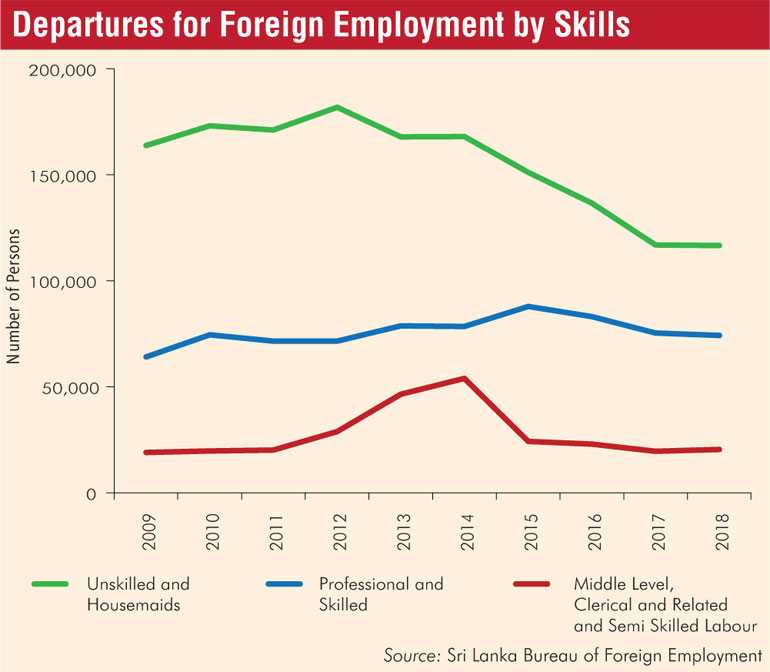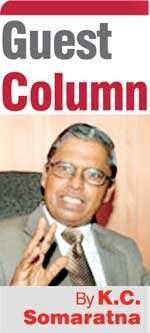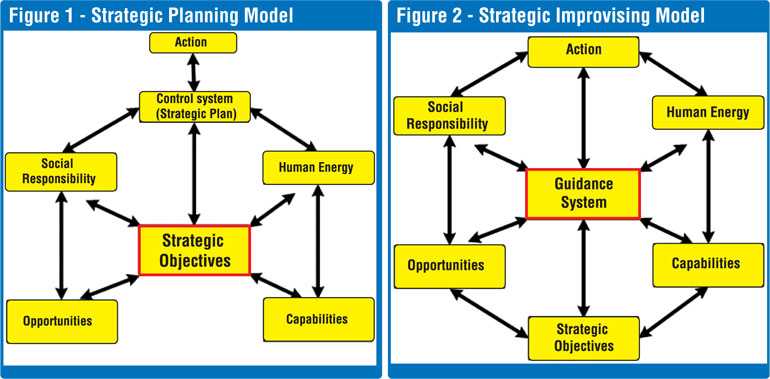Tuesday Nov 18, 2025
Tuesday Nov 18, 2025
Thursday, 25 July 2019 00:00 - - {{hitsCtrl.values.hits}}



When I saw the headlines of Prof. Ajantha Dharmasiri’s article on ‘Strategy Safari’ – the thought-provoking book by Prof. Henry Mintzberg, Bruce Ahlstrand and Joseph Lampel – I settled down to read the interesting article as I was promised it would shed light on how we could use lessons from this book to take Sri Lanka beyond the bitterness of the April Easter attack.
This book interested me at the beginning because it came four years after Mintzberg published his previous book ‘Rise and Fall of Strategic Planning’ in 1994. There he also wrote about the ten schools of strategic planning, with one difference, in that the Power School in Strategy Safari was called Political School in the previous book. 
My interest in Strategy was first kindled in October 1991 by the well-known ‘In Search of Excellence’ by Tom Peters and Robert Waterman, where they explained how McKinsey’s 7S model with the seven concepts including Strategy contributed to the exemplary success of 14 companies out of a total of sixty two they studied. The other six Ss were Structure, System, Style, Staff, Skills and Shared Values. It is interesting to note that when Tom Peters – the better known of the two McKinsey day colleagues – wrote his revolutionary ‘Circle of Innovation’ in 1997, Strategy was the only aspect out of the ‘S’s in 7S Model which did not find a place in the ‘15 discrete/biggish ideas’ which formed the Circle of Innovation. All the other ‘S’s were in the discrete/biggish ideas in the Circle of Innovation in the same form or a related form. The only one which got in with absolutely no change was the ‘System’, which formed a part of the 15 biggish ideas as well as the title of Chapter 8 ‘System is the Solution’. I thought it justified what I have been doing for Sri Lankan corporates – establishing Systems to manage ways and means of fulfilling expectations of their different stake holders – since 1994, three years before Circle of Innovation was published.
Then Prof. Dharmasiri goes on to elaborate certain characteristics of Strategy in respect of its content, complexity, consequences, variations and levels. Finally, he elaborates on Vision 2025 and raises questions related to this Vision 2025 and its implementation.
I thought that there are more lessons from the wider subject area of Strategy that could be used at this point of time in Sri Lanka and initiating a discussion of the same is the objective of this article. This takes me to jot down some thoughts on Strategic Planning and Strategic Improvising and a possible way forward for a more prosperous Sri Lanka.
We should thank Prof. Dharmasiri for bringing up the subject of Strategy as something which could help Sri Lanka at its current stage of confusion.
Strategic planning and strategic improvising
The second half of 1990s was a period when I spent a lot of time on Strategic Planning studies, going through many books looking for a unified approach. Strategy and Strategic Planning has been a very elusive area in management as could be seen from the portions which Prof. Dharmasiri quoted from ‘Strategy Safari’. It is further elaborated in the interesting sketch in where the elephant symbolising Strategic Management says, “To be perfectly frank, I’m not nearly as smart as you want to think I am.” I see closer agreement between this statement and Mintzberg’s title for his earlier book ‘Rise and Fall of Strategic Planning’.
But there would be lesser arguments on whether a corporate entity needs a strategy at a given point in time. Similarly, Sri Lanka needs a strategy at this point in time. Even a graduate level student in strategy would know that strategy formulation demands analysis of different components and this spectrum keeps on enlarging all the time. SWOT analysis, which held sway a few decades ago, had enlarged to the analysis of components ranging from technological, market to cultural, environmental areas etc. When we talk of market sizes of Sri Lanka and other countries, we are basically talking about this market aspect. Arising from this, we tend to plan to conquer the world by some empty words and terms such as ‘Hub of the Indian Ocean’, ‘Knowledge Economy’, etc. Our strategic thinking seems to stop there. How can there be a knowledge economy here, when more and more bearers of knowledge provided using loans from ADB and IDA etc. are being suggested as exports?1
In 1994, I read a book called Real Time Strategy, the Portable MBA version – at that time I was getting addicted to Portable MBA books, say on Strategy, Total Quality Management, and many more – where they were promoting Strategic Improvising instead of Strategic Planning. I was attracted to it because it matched well with some characteristics of corporate entities I myself had worked with. I never thought that in today’s world a company could move forward within a strategic framework which takes about one year to develop. Mintzberg et. al. quote that General Electric starts the strategic planning process around 3 January and plans to complete by around 6 December of the same year. I remember the cartoon which I saw in a Fortune magazine where somebody tells a colleague who returns after lunch that while he was away a new printer model came into being and went out of use. It is an indication of how fast the corporate world is moving today.
Sri Lanka needs a strategy at this point in time. Even a graduate level student in strategy would know that strategy formulation demands analysis of different components and this spectrum keeps on enlarging all the time. SWOT analysis, which held sway a few decades ago, had enlarged to the analysis of components ranging from technological, market to cultural, environmental areas etc. When we talk of market sizes of Sri Lanka and other countries, we are basically talking about this market aspect. Arising from this, we tend to plan to conquer the world by some empty words and terms such as ‘Hub of the Indian Ocean’, ‘Knowledge Economy’, etc. Our strategic thinking seems to stop there

In this fast-moving world, ‘Real Time Strategy’ promoted Strategic Improvising. The key difference between the two lies in the fact that in the Strategic Planning model, we arrive at a set of Strategic Objectives which will steer a Control system – the Strategic Plan – prompting and directing Action, whereas in the Strategic Improvising Model, the Strategic Objectives lead only to a Guidance System which leads to action. Please see figures 1 and 2 taken from ‘Real Time Strategy’.
Another key difference is that in Strategic Improvising, there are continuous communications between (a) Opportunities thrown out by the environment, (b) Organisational Capabilities, (c) Human Energy and (d) Social Responsibilities coordinated through both Strategic Objectives & Guidance System. The dynamic nature of Strategic Improvising really makes the entity adjust itself to changing circumstances while being alive to the Strategic Objectives and the Guidance System.
I do not intend to go into greater detail about the differences between the two approaches. But I wish to emphasise, we would be able to adjust to the new developments arising from the Easter Sunday attacks more easily within the Strategic Improvising model than within a Strategic Planning model. If we develop these capabilities within the upper echelons of the establishment, we could do so without waiting for external support from a foreign consultancy. It may be worthy to mention here that during the era of those centrally-planned economy days, we had better capabilities to implement Strategic Improvising than we have today; because planning capabilities, or rather the confidence in local planners in the ministries, were more visible then. Today, with dwindling external resources, we need to think twice before we go on a shopping spree for strategy improvising or fresh plan amendment capabilities.
Vision 2025
Prof. Dharmasiri then talks about what is in the Vision 2025. He talks about “securing opportunities for local businesses in global production networks …” and “increasing the efficiency of the domestic economy….” etc. I am not too sure as to how congruent this is with the New Economic Strategy formulated by the EDB. I beg to opine that both these are inward-focused strategies, whereas what we need is an outward focused strategy. An export strategy does not become outward-looking by merely talking about the market sizes of outside countries. Even the New Export Strategy has not become an outward-looking strategy for the same reason.
We always try to see how we can sell more of what we have and what we are already exporting, and it ends there. In our country strategies, we are trying to market what we could make the best rather than making what we could sell the best. In manufacturing we call it the ‘pushing model’ instead of the ‘pulling model’. Ever since Eliyahu Goldratt published his epoch-making book ‘Goal’ to demonstrate how profitable production entities could become by adopting the pulling model instead of the pushing model, the books written on this new concept and the associated Theory of Constraints are numerous.
In our country strategies, we are trying to market what we could make the best rather than making what we could sell the best. In manufacturing we call it the ‘pushing model’ instead of the ‘pulling model’…Even when we wrote about achieving $ 50 billion exports in 2050 to Daily FT we clearly mentioned this need to identify what is needed elsewhere and trying to see, out of those items, what we could make here. We see this aspect of matching global needs is missing in our approaches
Even when we wrote about achieving $ 50 billion exports in 2050 to Daily FT2 we clearly mentioned this need to identify what is needed elsewhere and trying to see out of those items what we could make here. We see this aspect of matching global needs is missing in our approaches.
Lessons from ‘Strategy Safari’
If one were to capture a set of lessons from Strategy Safari, it could be achieved by asking “better questions and generating fewer hypothesis – to allow ourselves to be pulled by the concerns out there rather than being pushed by the concepts in here,” quoting the last paragraph of the book. When we provided system-based solutions to local corporates, we were again addressing a need which had originated elsewhere in respect of our exports.
|
Having bought and read it in September 1999, this book with the extremely colourful jacket cover is amongst the most attractive 25 books in my library which get referred by me several times a year |
The beauty of this approach is that if our approach to economic development was based on what we have here and what we do here, the slightest local disruption would disturb our economic activity completely. But if our economic activity is a pulling model based on what is needed abroad, such disturbances would have a lesser impact on our economic activity potential.
My mind goes back to my days at Haycarb from 1986-1991, when there were many bomb explosions in the country, killing many a Sri Lankan. But, our Haycarb’s market place was overseas, as a result of which we could establish activated carbon manufacturing facilities elsewhere and retain the market. It was so because the founders of Haycarb identified what was in demand overseas and serviced that demand. In this respect, one could see that some industries being promoted currently are far more vulnerable to such destabilising attempts due to the fact that the servicing activity is planned to be carried out entirely in Sri Lanka itself.
At this particular point in time, one could see that within the Strategic Planning approach, the Strategic Objectives would have become disrupted. Once these objectives get disrupted, what lies beyond – Strategic Plan and Action points get disrupted automatically. This mainly stems from the fact that Strategic Planning model expects the Strategic Plan to stem from Strategic Objectives in an irreversible fashion and in Strategic Improvising, Action stems from the Guidance System – of course supported by Human Energy and Social Responsibilities from the two sides – and this Guidance System is also reliant on Capabilities and Opportunities.
If we take the current scenario, everybody knows that tourism industry is badly affected. So what do we do now? If we look at the New Export Strategy one could see that one of the key areas to be promoted is Wellness Tourism and I hope NES authors identified this being different from normal tourism. Let us develop a suitable Guidance System to strengthen Capabilities and Human Energy and exploit the opportunity provided – of course within a Social Responsibility framework – and forge ahead on Wellness Tourism. This might demand enhancement of facilities at tourism locations, capable people and some additional infrastructure. If those who formulated NES is confident of this field been a key export-earning industry, we could apply Strategic Improvising and still forge ahead. I am not going to wear the hat of an investment advisor here, but only explain how Strategic Improvising could help when things become disrupted.
Furthermore, I would expect this Guidance System in Strategic Improvising also to assist organisations during stages of transformation as well.
Managing the present from the future
In this article, I was trying to show you that strategic planning has become a tougher job, while the relevant knowledge base has come a long way to get where it is today. A few things disrupted the way companies were being managed. Both the customers and shareholders became more powerful in the second half of last decade of the previous century. The customer patronage was needed to maintain the promised profit margins, the lack of which had shareholders clamouring. CEOs of a few global Fortune 500 companies were being summoned asked to submit their resignations. This had its own impact on the local scenario as well.
The only way to survive in this set-up is to manage the companies from the future. In fact, this phrase was borrowed from the title of the last chapter of Portable MBA in Strategy. The CEO would demand a certain profit margin and the management had to fulfil that demand. Remember CEOs of companies like General Electric would be demanding reduction of waste by a certain percentage and the workforce had to provide the same. The necessary, relevant techniques like Six Sigma came into the C-suite vocabulary.
It is in this business environment that we are talking about Strategic Planning, etc. It is doubtful whether appropriate strategies could be developed which would remain relevant even for one year in today’s world. At least, we need to develop capabilities which would cater to the expectations of customers in such a dynamic environment.
Coming back to the current situation I would urge corporate leaders to make use of this opportunity to prepare themselves for the future. If I were to quote from Louis Patler’s book ‘Don’t Compete; tilt the field’ there are a few lessons you can learn from basketball which would help you in Strategy formation: (1) See the whole court, (2) Move without the ball, (3) Use the backboard, (4) Make (practice, I might say) free throws and (5) Know thy teammates.
Conclusion
What I tried to emphasise to the reader or the business personnel is looking the current situation as an opportunity to target greater levels of achievement. A Strategic Improvising type of approach would come in handy. I suggested a possible approach with respect to the tourism industry, quoting from National Export Strategy. I again emphasised the need for a pulling type of approach to succeed in many things including exports. I also took it from the mundane to the abstract level by saying that we should start planning for the present from the future. I do not have the slightest doubt that we will rise from this.
Of course, whenever I indulge in strategy formulation for anybody, I would end it with the following statement again from Louis Patler: “Good strategy is like good philanthropy, it becomes ‘good’ only when put to good use.”
I should thank Prof. Dharmasiri for rekindling my thought processes on strategy to a level which would, I presume, meet the expectations of the readership. If not for his article, I would have never shared these thoughts.
(The writer is the Managing Director of Somaratna Consultants Ltd.)
Footnotes:
1.CBSL Annual Report 2018 pages 135 and 136
2.www.ft.lk/article/528429/--50-b-exports-in-2050-is-nothing--tell-me-the-price-of-oil-in-2050